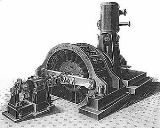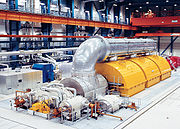
Turbo generator
Encyclopedia


Turbine
A turbine is a rotary engine that extracts energy from a fluid flow and converts it into useful work.The simplest turbines have one moving part, a rotor assembly, which is a shaft or drum with blades attached. Moving fluid acts on the blades, or the blades react to the flow, so that they move and...
directly connected to an electric generator for the generation of electric power
Electric power
Electric power is the rate at which electric energy is transferred by an electric circuit. The SI unit of power is the watt.-Circuits:Electric power, like mechanical power, is represented by the letter P in electrical equations...
. Large steam powered
Steam turbine
A steam turbine is a mechanical device that extracts thermal energy from pressurized steam, and converts it into rotary motion. Its modern manifestation was invented by Sir Charles Parsons in 1884....
turbo generators (steam turbine generators) provide the majority of the world's electricity and are also used by steam powered turbo-electric
Turbo-electric
A turbo-electric transmission uses electric generators to convert the mechanical energy of a turbine into electric energy and electric motors to convert it back into mechanical energy to power the driveshafts....
ships.
Smaller turbo-generators with gas turbine
Gas turbine
A gas turbine, also called a combustion turbine, is a type of internal combustion engine. It has an upstream rotating compressor coupled to a downstream turbine, and a combustion chamber in-between....
s are often used as auxiliary power unit
Auxiliary power unit
An auxiliary power unit is a device on a vehicle that provides energy for functions other than propulsion. They are commonly found on large aircraft, as well as some large land vehicles.-Function:...
s. For base loads diesel generator
Diesel generator
A diesel generator is the combination of a diesel engine with an electrical generator to generate electrical energy....
s are usually preferred, since they offer much better fuel efficiency
Fuel efficiency
Fuel efficiency is a form of thermal efficiency, meaning the efficiency of a process that converts chemical potential energy contained in a carrier fuel into kinetic energy or work. Overall fuel efficiency may vary per device, which in turn may vary per application, and this spectrum of variance is...
and are also more reliable, but on the other hand they are much heavier and need more space.
The efficiency of larger gas turbine plants can be enhanced by using a combined cycle
Combined cycle
In electric power generation a combined cycle is an assembly of heat engines that work in tandem off the same source of heat, converting it into mechanical energy, which in turn usually drives electrical generators...
, where the hot exhaust gas
Exhaust gas
Exhaust gas or flue gas is emitted as a result of the combustion of fuels such as natural gas, gasoline/petrol, diesel fuel, fuel oil or coal. According to the type of engine, it is discharged into the atmosphere through an exhaust pipe, flue gas stack or propelling nozzle.It often disperses...
es are used to generate steam
Steam
Steam is the technical term for water vapor, the gaseous phase of water, which is formed when water boils. In common language it is often used to refer to the visible mist of water droplets formed as this water vapor condenses in the presence of cooler air...
which drives another turbo generator.
History
The Turbo generator was invented by a HungarianHungary
Hungary , officially the Republic of Hungary , is a landlocked country in Central Europe. It is situated in the Carpathian Basin and is bordered by Slovakia to the north, Ukraine and Romania to the east, Serbia and Croatia to the south, Slovenia to the southwest and Austria to the west. The...
engineer Ottó Bláthy
Ottó Bláthy
Ottó Titusz Bláthy was a Hungarian electrical engineer. In his career, he became the co-inventor of the modern electric transformer, the tension regulator, , the AC watt-hour meter, the single-phase alternating current electric motor, the turbo generator, and the high efficiency turbo...
.
Turbo generators were also used on steam locomotives as a power source for coach lighting and heating systems.
Hydrogen-cooled turbogenerator
Based on the air-cooled turbo generator, gaseous hydrogenHydrogen
Hydrogen is the chemical element with atomic number 1. It is represented by the symbol H. With an average atomic weight of , hydrogen is the lightest and most abundant chemical element, constituting roughly 75% of the Universe's chemical elemental mass. Stars in the main sequence are mainly...
went into service as a coolant
Coolant
A coolant is a fluid which flows through a device to prevent its overheating, transferring the heat produced by the device to other devices that use or dissipate it. An ideal coolant has high thermal capacity, low viscosity, is low-cost, non-toxic, and chemically inert, neither causing nor...
in the rotor and sometimes the stator
Stator
The stator is the stationary part of a rotor system, found in an electric generator, electric motor and biological rotors.Depending on the configuration of a spinning electromotive device the stator may act as the field magnet, interacting with the armature to create motion, or it may act as the...
of hydrogen-cooled turbogenerator
Hydrogen-cooled turbogenerator
A hydrogen-cooled turbo generator is a turbo generator with gaseous hydrogen as a coolant. Hydrogen-cooled turbo generators are designed to provide a low-drag atmosphere and cooling for single-shaft and combined-cycle applications in combination with steam turbines...
s in 1937 at Dayton, Ohio
Dayton, Ohio
Dayton is the 6th largest city in the U.S. state of Ohio and the county seat of Montgomery County, the fifth most populous county in the state. The population was 141,527 at the 2010 census. The Dayton Metropolitan Statistical Area had a population of 841,502 in the 2010 census...
, in October by the Dayton Power & Light Co allowing an increase in specific utilization and a 99.0 % efficiency, because of the high thermal conductivity
Thermal conductivity
In physics, thermal conductivity, k, is the property of a material's ability to conduct heat. It appears primarily in Fourier's Law for heat conduction....
, high specific heat and low density
Density
The mass density or density of a material is defined as its mass per unit volume. The symbol most often used for density is ρ . In some cases , density is also defined as its weight per unit volume; although, this quantity is more properly called specific weight...
of hydrogen gas this is the most common type in its field today. The hydrogen can be manufactured on-site by electrolysis
Electrolysis
In chemistry and manufacturing, electrolysis is a method of using a direct electric current to drive an otherwise non-spontaneous chemical reaction...
.
The generator is hermetically sealed to prevent escape of the hydrogen gas. The absence of oxygen
Oxygen
Oxygen is the element with atomic number 8 and represented by the symbol O. Its name derives from the Greek roots ὀξύς and -γενής , because at the time of naming, it was mistakenly thought that all acids required oxygen in their composition...
in the atmosphere within significantly reduces the damage of the windings insulation by eventual corona discharge
Corona discharge
In electricity, a corona discharge is an electrical discharge brought on by the ionization of a fluid surrounding a conductor that is electrically energized...
s. The hydrogen gas is circulated within the rotor enclosure, and cooled by a gas-to-water heat exchanger
Heat exchanger
A heat exchanger is a piece of equipment built for efficient heat transfer from one medium to another. The media may be separated by a solid wall, so that they never mix, or they may be in direct contact...
.

